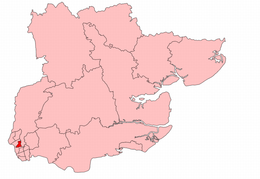Leyton East (UK Parliament constituency)
| Leyton East | |
|---|---|
|
Former Borough constituency for the House of Commons | |
| 1918–1950 | |
| Number of members | one |
| Replaced by | Leyton |
| Created from | Walthamstow |
Leyton East was a parliamentary constituency in the Municipal Borough of Leyton, then part of Essex but now in Greater London.
It returned one Member of Parliament (MP) to the House of Commons of the Parliament of the United Kingdom, elected by the first past the post system.
Boundaries

Leyton East in Essex 1918-1950
The Urban District of Leyton wards of Cann Hall, Grove Green, Harrow Green, Leytonstone, and Wanstead Slip.
History
The constituency was created for the 1918 general election, and abolished for the 1950 general election.
Members of Parliament
| Election | Member | Party | |
|---|---|---|---|
| 1918 | Cecil Malone | Liberal | |
| 1919 | British Socialist | ||
| 1920 | Communist | ||
| 1922 | Ernest Edward Alexander | Unionist | |
| 1923 | Archibald Church | Labour | |
| 1924 | Ernest Edward Alexander | Unionist | |
| 1929 | Fenner Brockway | Labour | |
| 1931 | Sir Frederick Mills | Conservative | |
| 1945 | Albert Bechervaise | Labour | |
| 1950 | constituency abolished: see Leyton | ||
Elections
Elections in the 1920s
| Party | Candidate | Votes | % | ± | |
|---|---|---|---|---|---|
| Labour | Archibald Church | 7,944 | 39.5 | +8.6 | |
| Unionist | Ernest Edward Alexander | 6,533 | 32.4 | ||
| Liberal | Thomas Broad | 5,669 | 28.1 | ||
| Majority | 1,411 | 7.1 | |||
| Turnout | 69.1 | -3.1 | |||
| Labour gain from Unionist | Swing | ||||
| Party | Candidate | Votes | % | ± | |
|---|---|---|---|---|---|
| Labour | Fenner Brockway | 11,111 | 42.9 | ||
| Unionist | Ernest Edward Alexander | 8,691 | 33.6 | ||
| Liberal | Frank Wynne Davies | 6,096 | 23.5 | ||
| Majority | 2,420 | 9.3 | |||
| Turnout | 72.6 | ||||
| Labour gain from Unionist | Swing | ||||
Elections in the 1930s
| Party | Candidate | Votes | % | ± | |
|---|---|---|---|---|---|
| Conservative | Frederick Mills | 17,285 | 62.4 | ||
| Ind. Labour Party | Fenner Brockway | 10,433 | 37.6 | ||
| Majority | 6,852 | 24.8 | |||
| Turnout | 75.7 | ||||
| Conservative gain from Labour | Swing | ||||
| Party | Candidate | Votes | % | ± | |
|---|---|---|---|---|---|
| Conservative | Frederick Mills | 10,836 | 46.1 | ||
| Labour | Albert Bechervaise | 10,507 | 44.7 | ||
| Liberal | Edwin Malindine | 2,161 | 9.2 | ||
| Majority | 329 | 1.4 | |||
| Turnout | 67.1 | ||||
| Conservative hold | Swing | ||||
Elections in the 1940s
| Party | Candidate | Votes | % | ± | |
|---|---|---|---|---|---|
| Labour | Albert Bechervaise | 13,048 | 65.7 | ||
| Conservative | Bernard Braine | 6,802 | 34.3 | ||
| Majority | 6,246 | 31.5 | |||
| Turnout | 68.2 | ||||
| Labour gain from Conservative | Swing | ||||
References
- ↑ British Parliamentary Election Results 1918-1949, FWS Craig
- Craig, F. W. S. (1983) [1969]. British parliamentary election results 1918-1949 (3rd ed.). Chichester: Parliamentary Research Services. ISBN 0-900178-06-X.
- Leigh Rayment's Historical List of MPs – Constituencies beginning with "L" (part 2)
This article is issued from
Wikipedia.
The text is licensed under Creative Commons - Attribution - Sharealike.
Additional terms may apply for the media files.